Alhough I'm a big fan of tablet, fudge's crumbly, grainy Scottish cousin, I deeply regret the fact I can no longer do it justice. Any recipe that calls for a kilo of caster sugar is not for the merely sweet of tooth: you need to be a serious sugar junkie to enjoy this in bulk. Or, as I did last weekend, you need to climb a mountain in the driving rain. At the top, in the snow, suddenly square after square of the stuff makes perfect sense.
This kind of weather, and calorific exertion, is what tablet was designed for – it has been enjoyed in Scotland since at least the 18th century, when life was hard and the weather seriously dreich. That said, tiny wee morsels make a superb end to a modern Burns Night feast – it only comes once a year, after all.
Now, I know there's been a backlash against sugar in recent weeks, and any which way you look at it, tablet is not a health food. It should be consumed strictly in moderation – in fact, I defy anyone to consume it any other way.
Sugar
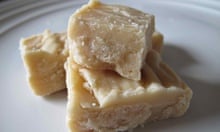
Sugar is the foundation of a good tablet. The main division seems to be over the texture: Sue Lawrence, Nick Nairn and the blog Not So Humble Pie all use granulated, while the inimitable Maw Broon of the cartoon series in the Scottish Sunday Post goes for caster, and Russell, a Scot who runs the blog London Eats, just specifies white. I don't find it makes much difference to the end result, but as you need the sugar to dissolve, caster makes more sense. Lawrence suggests using golden sugar, which helps with the caramelised flavour.
Butter
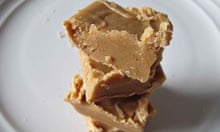
Butter, happily, makes up a relatively small proportion of the ingredients here. Lawrence, Not So Humble Pie and London Eats use unsalted, while the Broon recipe uses salted, for maximum medical disapproval. I think a certain degree of salt is necessary here to balance the intense sweetness (only London Eats wisely specifies adding extra), so I'm not sure it matters at which point you add it. Not So Humble Pie melts the butter first before adding it to the mixture, which seems unnecessary – just do it in the pan. Saves on washing up.
Liquid
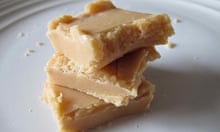
This is where things get interesting. Early recipes, according to F Marian McNeill's The Scots Kitchen, consist of little more than sugar and cream, but I only find one modern version including cream, from Not So Humble Pie. She uses the higher fat content to inhibit over-crystallisation – tablet should be slightly sandy in texture, but stop short of grittiness. Her version does have a lovely, rich flavour, but on balance I prefer the slightly lighter results of the others – tablet should be sugary, rather than creamy. (That's what fudge is for.)
Condensed milk usually figures, often in combination with the fresh stuff: Maw Broon uses more condensed than fresh, while Lawrence does things the other way around. Controversially, Nairn goes for a combination of hot water and condensed milk, while London Eats swaps evaporated milk for the condensed variety, which gives his tablet a slightly odd boiled milk flavour and crunchy texture. If you grew up on it, no doubt that's desirable, but I prefer the soft richness of the condensed sort.
Nairn's, though utterly delicious, is softer than any tablet I've had before – almost melt in the mouth – while both Broon's and Lawrence's have a more robust texture; the former slightly softer, the latter almost snappable. I suspect the ratio of condensed to fresh milk makes the difference; I prefer Broon's creamier version.
Method
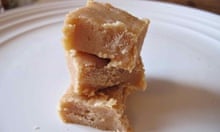
The most complicated method comes from Not So Humble Pie, who cites problems with crystallisation for her caution – she washes down the side of the pot obsessively (standard practice for a smooth texture in confectionery) and calls for constant stirring (a tricky combination with only two hands). I clearly do something wrong, because her tablet is the only gritty one of the lot, despite nearly driving me up the wall with a damp pastry brush.
Lawrence's tablet is the quickest to make, but I think the short cooking time means the ingredients don't have time to caramelise properly; it's very pale in comparison to the others. Far better to take things more slowly, like the others, stirring occasionally so it doesn't burn.
That said, her advice about using electric beaters on the mixture once it comes off the heat (in order to give it that distinctive sandy texture) saves a good 10 minutes of vigorous activity. Although, as Not So Humble Pie observes, doing it manually will "make your arm very, very sore, but if you're eating this tablet you're going to need the burn".
I'd advise using a sugar thermometer to tell when it's done: 115C is the magic number. If you don't have one, you could use the cold water test (drop a teaspoon into cold water; if you can rub it between your fingers, it's done) but I think Nairn's advice about dribbling a little on to a cold plate and seeing if it sets is easier to judge.
Flavourings
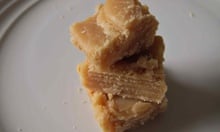
Vanilla is common in tablet recipes, but if you've caramelised the ingredients properly, it's unnecessary. As London Eats points out, you could use any number of spices, but "this way you get all the rich flavours of cooked milk and caramelised sugar, which can be so easily lost when you add more aromatic ingredients". Hear, hear; the same goes for Nairn's vanilla-flecked white chocolate.
The one addition I might make an exception for, on Burns Night, is whisky, but you have to add a surprising amount to get the flavour to come through in the finished sweet. Frankly, I'd advise washing it down with a wee dram instead.
The perfect tablet
125g butter, plus extra to grease
1kg golden sugar (granulated or caster)
½ tsp salt
250ml whole milk
350ml condensed milk
½ tsp vanilla extract (optional)
Grease a shallow tin approximately 25cm x 35cm. Melt the butter in a large, heavy-based pan (as tall as you have) over a low heat. Add the sugar, salt and milk and stir until the sugar has dissolved. Bring to the boil and simmer over a fairly high heat for eight minutes.
Add the condensed milk, stir well, then turn the heat down and let it simmer for about another 15 minutes, stirring occasionally. Start testing at this point: once it reaches 115C, it's done. (Alternatively, dribble some of the mixture on to a cold saucer. Leave for a couple of minutes, then push it with your finger; if it sets, it's done.)
Take off the heat, add any flavourings, if using, and beat vigorously with a wooden spoon or electric beaters until thickened but still pourable (about 10 minutes if done manually, less with beaters). Pour into the prepared tin and leave to set, scoring squares after about 20 minutes. It is best left out to dry slightly overnight.
Tablet: sandy manna from heaven, fudge gone wrong or the kind of evil that needs eliminating from the Scottish diet? Has anyone had any success in incorporating it into a dessert – and will anyone speak up in favour of evaporated milk?
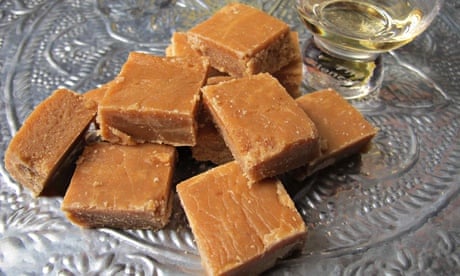
Comments (…)
Sign in or create your Guardian account to join the discussion